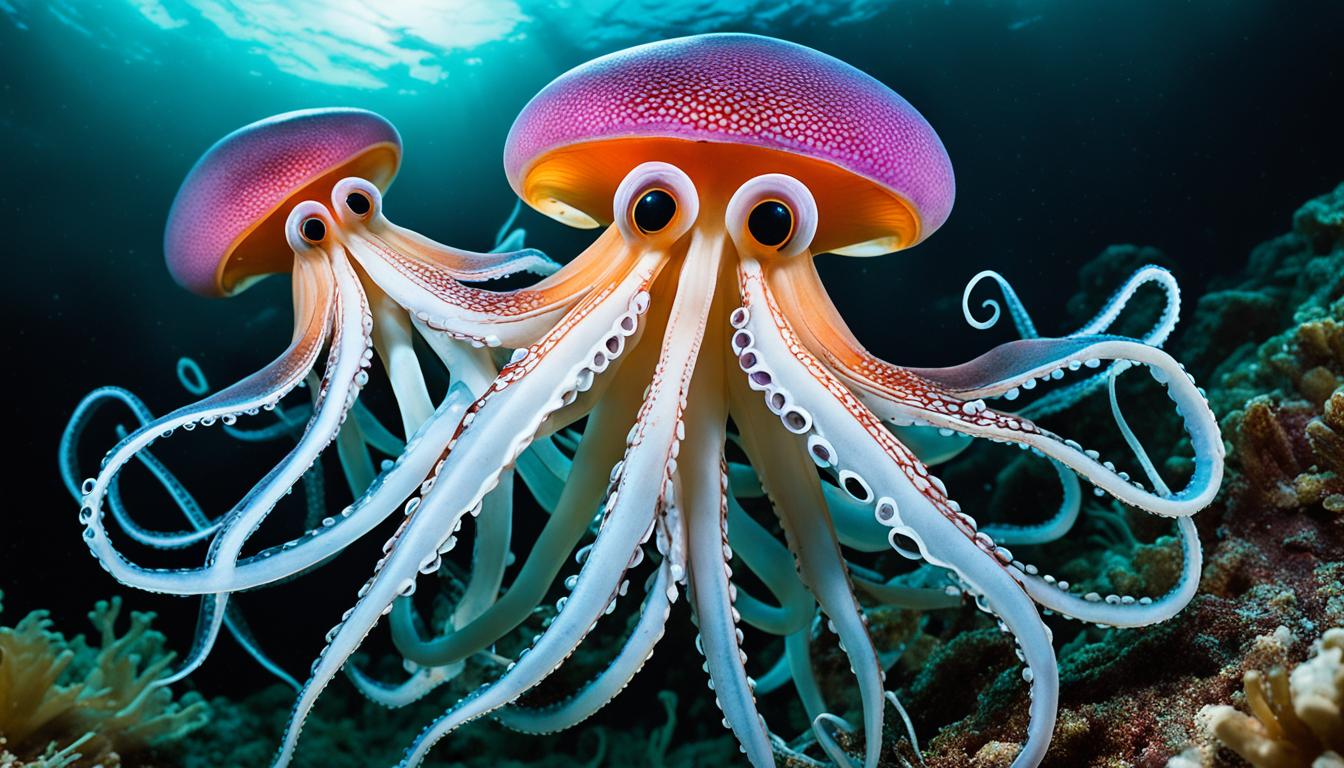The way giant squids reproduce is both fascinating and a bit of a mystery. Learning about their reproductive habits helps us understand their importance in the deep sea. These mysterious creatures have mating behaviors that are key to their survival. You’ll also learn about the challenges scientists face in studying their reproduction.
Giant squid reproduction cycle
The giant squid’s reproduction cycle shows how it adapts to its environment. It helps us understand these mysterious sea creatures better. These squids live about five years, focusing on reproducing during this short time.
Life span and reproductive frequency
Giant squids make reproduction a top priority in their short lives. They usually reproduce just once. This highlights how crucial it is for their species to survive.
They release millions of jelly-like eggs into the ocean. These eggs form clusters that many predators target. This shows how urgent their reproductive strategy is.
Their short lives mean they must grow fast. They eat a lot to grow big and strong quickly.
| Aspect | Details |
|---|---|
| Average Life Span | 5 years |
| Reproductive Frequency | Once in a lifetime |
| Egg Release | Millions of jelly-like eggs |
| Mortality of Eggs | Subject to predation |
| Growth Diet | Rich in prey |
How do giant squids reproduce?
The way giant squids reproduce is quite fascinating. Their mating habits are unique among cephalopods. These behaviors show how they ensure their species thrives.
Unique mating behaviors
Giant squid have special ways of mating. Males have a unique method to transfer sperm. They use a long penis and a structure called a spermatophore to do this.
This method is different from other squids. Chemical signals might also be important in their mating. The exact details are still a mystery, but it seems they communicate and physically interact to ensure successful reproduction.

Giant squid reproductive anatomy
Exploring the reproductive anatomy of giant squid shows us amazing adaptations. These help them survive and reproduce well. Both males and females have unique features that show how these creatures have evolved.
Male anatomical adaptations
The male giant squid has special genital organs for better sperm transfer. These can grow up to seven feet long. This length helps males reach females in deep-sea places where it’s hard to see.
Female reproductive structures
Female giant squids have big, soft sacs for their eggs. These sacs keep the eggs safe from currents and predators. This shows how the giant squid’s body is designed to help their species survive in tough conditions.
Giant squid breeding behavior
Giant squid have fascinating ways to breed successfully. They use chemical signaling in mating and show group spawning tendencies. These behaviors help us understand their complex lives.
Chemical signaling in mating
When it’s time to mate, giant squids use chemical signals to find each other. Males release pheromones that attract females. This makes finding a mate easier for them.
Group spawning tendencies
Giant squids often spawn in groups. Many females release eggs at the same time. This helps ensure more eggs get fertilized and some survive predators.
Challenges in understanding giant squid reproduction
The study of giant squid reproduction faces big challenges because they are hard to observe. These creatures live deep in the ocean, making it tough for scientists to watch them. They are rarely seen and can quickly hide, giving scientists few chances to study them up close.
We learn most about giant squids from dead ones that wash up on shore. But, this might not show how they act when alive. This makes studying them hard, as what we see in dead squids might not be what they do in the ocean.
Scientists are now using new tech to learn more about giant squid reproduction. They use submersibles with special cameras and sensors to study these deep-sea creatures. These efforts could help us understand how giant squids live and reproduce in the deep ocean.
FAQ
How do giant squids reproduce?
Giant squids release millions of jelly-like eggs into the water. This shows how urgent their reproduction is. They live about five years.
What is the giant squid reproduction cycle?
The giant squid reproduction cycle is linked to their short life. They usually reproduce just once, making sure their species continues to thrive.
What unique mating behaviors do giant squids exhibit?
Giant squids have special mating behaviors. Males use a long penis to put sperm directly into the female’s arms. This is different from many other squid species.
What are the anatomical adaptations of male giant squids?
Male giant squids have long genital organs, up to seven feet. This helps them transfer sperm during mating.
What reproductive structures do female giant squids have?
Female giant squids have big jelly-like sacs for storing fertilized eggs. This helps keep the eggs safe in their deep-sea home.
How does chemical signaling play a role in giant squid mating?
Some think that chemical signals, like pheromones, help males find females during mating. This adds more complexity to their mating process.
Do giant squids engage in group spawning?
Yes, giant squids often spawn in groups. Many females release eggs at the same time. This might help their babies survive better.
What challenges do researchers face in studying giant squid reproduction?
Studying giant squid reproduction is hard because they are hard to find and live deep in the sea. This makes it tough to watch them and gather data.







